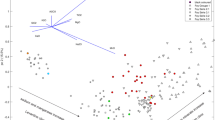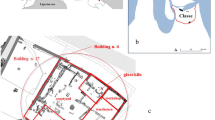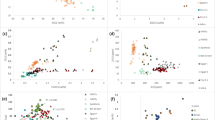Abstract
Thesprotia, one of the most remote regions in Greece, was inhabited from as early as the Palaeolithic period. The particular geomorphological terrain, with the mountainous and fragmented landscape, has been determinant in the formation of economic and social institutions throughout antiquity. Thesprotia was gradually developed into an important node of communication and transport of goods to the West and the mountainous hinterland of Epirus. During the second half of fourth century BC, socioeconomic changes occurred in the region and small villages were joined to form the first organised settlements. Elea, Gitana and Dymokastro were founded within a few years from one another, during the fourth century BC. Built at geographically crucial locations that ensured the control of the valleys or the riverside crossings and sea routes, they evolved gradually into political, economic and administrative centres for the surrounding areas. In the present study, 56 samples of glass, excavated from these three sites in Thesprotia, are investigated using analytical techniques (SEM-EDX and LA-ICP-MS). The chemical compositions of the samples show significant differences in raw materials used and provide evidence for provenance for the artefacts. This is the first study to examine Hellenistic glass from within a region of northern Greece. The results are compared with other published compositional data for Hellenistic glass. The analytical results for the majority of glass samples from the three sites in Thesprotia show with high probability a Levantine origin and therefore also possibly for the artefacts themselves. This confirms the archaeological record of trade in other materials/objects, while a small group of glasses from Gitana in Thesprotia were made in Egypt.










Similar content being viewed by others
References
Ayres M, Harris N (1997) REE fractionation and Nd-isotope disequilibrium during crustal anatexis: constraints from Himalayan leucogranites. Chem Geol 139(1-4):249–269
Beltsios KG, Oikonomou A, Zacharias N, Triantafyllidis P (2012) Characterization and provenance of archaeological glass artifacts from mainland and Aegean Greece. In: Liritzis I, Stevenson C (eds) The dating and provenance of volcanic and ancient manufactured glasses-a global overview. University of New Mexico Press, Albuquerque, pp 166–184
Bertini C, Henderson J, Chenery S (2020) Seventh to eleventh century CE glass from Northern Italy: between continuity and innovation. J Archaeol Anthropol Sci 12:120. https://doi.org/10.1007/s12520-020-01048-8
Blomme A, Degryse P, Dotsika E, Ignatiadou D, Longinelli A, Silvestri A (2017) Provenance of polychrome and colourless 8th–4th century BC glass from Pieria, Greece: a chemical and isotopic approach. J Archaeol Sci 78:134–146
Blomme A, Elsen J, Brems D, Shortland A, Dotsika E, Degryse P (2016) Tracing the primary production location of core-formed glass vessels, Mediterranean Group I. J Archaeol Sci Rep 5:1–9
Brill RH, Stapleton CP (2012) Chemical Analyses of Early Glasses, Volume 3, the Years 2000–2011, Reports, and Essays. The Corning Museum of Glass, Corning NY
Brill RH (1988) Scientific investigations of the Jalame glass and related finds. In: Weinberg GD (ed) Excavations at Jalame. University of Missouri Press, Columbia, Site of a Glass Factory in Late Roman Palestine, pp 257–294
Brill RH (1999) Chemical analyses of early glasses, vol 1&2. The Corning Museum of Glass, Corning NY
Cabanes P (1976) L’ Épire de la mort de Pyrrhos à la conquête romaine, Paris
Ceglia A, Cosyns P, Nys K, Terryn H, Thienpont H, Meulebroeck W (2015) Late antique glass distribution and consumption in Cyprus: a chemical study. J Archaeol Sci 61:213–222
Chapman T, Clarke GL, Daczko NR (2016) Crustal differentiation in a thickened arc-evaluating depth dependences. J Petrol 57(3):595–620
Cheilakou E, Liarokapi N, Koui M (2012) Non destructive characterization by FOM and ESEM-EDX of ancient glass objects from the Aegean with an approach of the manufacturing technique. Mater Struct 45(1-2):235–250
Connolly P, Rehren Th, Doulgeri-Intzesiloglou A, Arachoviti P (2012) The Hellenistic glass of Pherai, Thessaly, in: D. Ignatiadou - A. Antonaras, (eds), Annales du 18e Congrès del’ Association Internationale pour l’Histoire du Verre, pp. 91–97.
Cosyns P, Nys K (2010) Core-formed glass vessels on Cyprus reconsidered. In: Christodolou, S., Satraki, A. (Eds.), Proceedings of POCA 2007 (Nicosia, October 2007). Cambridge Scholars Publishing, Newcastle Upon Tyne, 231–261.
Cosyns P, Oikonomou A, Ceglia A, Michaelides D (2018) Late Hellenistic and early Roman slumped and cast glass vessels from the House of Orpheus at Paphos, Cyprus. An Interim Report. J Archaeol Sci Rep 22:524–539
Dakaris S (1972) Thesprotia, Ancient Greek Cities 15. Athens (in Greek)
Dardeniz G (2015) Was ancient Egypt the only supplier of natron? New research reveals major Anatolian deposits. Anatolica 41:191–202
Degryse P (ed) (2014) Glass making in the Greco-Roman world. Results of the ARCHGLASS Project, Leuven University Press
Devulder V, Vanhaecke F, Shortland A, Mattingly D, Jackson C, Degryse P (2014) Boron isotopic composition as a provenance indicator for the flux raw material in Roman natron glass. J Archaeol Sci 46:107–113
Foy D, Picon M, Vichy M and Thirion-Merle V (2003) Caractérisation des verres de la fin de l’Antiquité en Méditerranée occidentale: l’émergence de nouveaux courants commerciaux, Échanges et commerce du verre dans le monde antique, pp 41-85.
Foy D (2005) Une production de bols moulés à Beyrouth à la fin de l'époque hellénistique et le commerce de ces verres en Méditerranée occidentale. J Glass Stud 47:11–35
Franke, P.R., 1961. Die antiken Münzen von Epirus, Wiesbaden.
Freestone IC, Degryse P, Lankton J, Gratuze B, Schneider J (2018) HIMT, glass composition and commodity branding in the primary glass industry. In: Rosenow D, Phelps M, Meek A, Freestone IC (eds) Things That Travelled: Glass in the First Millennium CE. UCL Press, London, pp 159–190
Freestone IC, Gorin-Rosen Y, Hughes MJ (2000) Primary glass from Israel and the production of glass in late antiquity and the Early Islamic period. In: Nenna, M-D. (ed), La route du verre. Ateliers primaires et secondaires du second millénaire av. J.C. au MoyenÂge, Maison de l’Orient Méditerranéen-Jean Pouilloux, Lyon, pp. 65–83.
Gratuze B, Barrandon JN (1990) Islamic glass weights and stamps-analysis using nuclear techniques. Archaeometry 32:155–162
Grose DF (1989) Early ancient glass: core-formed, rod-formed, and cast vessels and objects from the Late Bronze Age to the Early Roman Empire, 1600 BC to 50 AD, The Toledo Museum of Art, Hudson Hills Press in Association with the Toledo Museum of Art, New York.
Hammond NGL (1967) Epirus. The geography, the Ancient remains, the history and the topography of Epirus and adjacent areas, Oxford.
Harden DM (1980) A Hellenistic footed glass bowl of Alexandrine Origin. Toledo Museum of Arts, Museum News 22, pp 17–25.
Henderson J (2013) Ancient glass, an interdisciplinary exploration, Cambridge University Press, New York and Cambridge.
Henderson J, Ma H and Evans J (2020) Glass production for the Silk Road? Provenance and trade of Islamic glasses using isotopic and chemical analyses in a geological context. J Archaeol Sci, 119: 105164
Jackson CM and Cottam S (2015) ‘A green thought in a green shade’; compositional and typological observations concerning the production of emerald green glass vessels in the 1st century A.D. J Archaeol Sci, 61:139–148.
Jackson CM, Paynter S, Nenna MD, Degryse P (2018) Glassmaking using natron from el-Barnugi (Egypt); Pliny and the Roman glass industry. J Archaeol Anthropol Sci 10(5):1179–1191
Jochum KP, Weis U, Stoll B, Kuzmin D, Yang Q, Raczek I, Jacob DE, Stracke A, Birbaum K, Frick DA, Günther D, Enzweiler J (2011) Determination of reference values for NIST SRM 610-617 glasses following ISO guidelines. Geostand Geoanal Res 35(4):397–429
Kanta-Kitsou A (2008) Gitana Thesprotias. Archaeological Guide, Athens (in Greek)
Kowatli I, Curvers HH, Stuart B, Sablerolles Y, Henderson J, Reynolds P (2008) A pottery and glassmaking site in Beirut (015). Bulletin de Archéologie et d’ Architecture Libanaises 10:103–120
Lazari K, Tzortzatou A, Kountouri K (2008) Dymokastro Thesprotias. Archaeological Guide, Athens (in Greek)
Lévêque P (1957) Pyrrhos, Paris
Liakos L, and Vasileiadis S (2008) Determination of the area of exploitation and movement routes of the ancient settlements of Thesprotia and southern Albania using the surface cost analysis and the model Xtent., Proceedings of the 10th National Conference on Cartography, Hellenic Cartographic Society (in Greek).
Nenna MD (1998) Les ateliers de verriers dans le monde grec aux époques classique et hellénistique. TOΠOI 8(2):693–701
Nenna M.-D. (2014) Egyptian glass abroad: HIMT glass and its market. In: D., Keller, J., Price and C., Jackson, (eds.), Neighbours and successors of Rome – Traditions of glass production and use in Europe and the Middle East in the later 1st millennium AD, Oxbow Books, pp 177–193.
Nenna MD, Picon M, Vichy M (2000) Ateliers primaires et secondaires en Égypte à l’époque Gréco-romaine, in M.D. Nenna (ed.), La route du Verre. Ateliers primaires et secondaires du second millénaire av. J.-C. au Moyen Âge, Maison de l’Orient Méditerranéen-Jean Pouilloux, Lyon, pp 97–112.
Oikonomou A, Triantafyllidis P (2018) An archaeometric study of Archaic glass from Rhodes, Greece: technological and provenance issues. J Archaeol Sci Rep 22:493–505
Oikonomou A (2019) An interdisciplinary study of Hellenistic glass objects from Thesprotia, Greece, in Chouliaras, I.P. and Pliakou, G.Th., (eds.), Thesprotia I. Proceedings of the 1st International Conference on the Archaeology and History of Thesprotia, Ministry of Culture and Sports, Ephorate of Antiquities of Thesprotia, Ioannina, pp 345–360, (in Greek).
Oikonomou A (2018) Hellenistic core formed glass from Epirus, Greece. A technological and provenance study. J Archaeol Sci Rep 22:513–523
Oikonomou A, Beltsios K, Zacharias N (2012) Analytical and technological study of an ancient glass collection from Thebes, Greece: an overall assessment. In: Ignatiadou, D., Antonaras, A., (eds), Annales du 18e Congrès del’ Association Internationale pour l’Histoire du Verre, pp 81–86.
Oikonomou A, Beltsios K, Zacharias N, Triantafyllidis P (2014) Technological and provenance study of archaic glassy materials from Rhodes Island using XRF and SEM/EDX analysis. Proceedings of the 39th International Symposium on Archaeometry, 28 May – 1 June 2012, Leuven, Belgium, pp 245–250
Oikonomou A, Triantafyllidis P, Beltsios K, Zacharias N, Karakassides M (2008) Raman structural study of ancient glass artefacts from the island of Rhodes. J Non-Cryst Solids 354(2–9):768–772
Palamara E, Zacharias N, Kamitsos EI, Oikonomou A, Palles D, Möncke D (2015) Spectroscopic study of a historical glass collection from Thebes, Greece, by Raman and IR, in: Photos Jones, E., (ed), in collaboration with Bassiakos, Y., Filippaki, E., Hein, A., Karatasios, I., Kilikoglou, V., Kouloumpi, E., Proceedings of the 6th Symposium of HAS, British Archaeological Reports, pp 59–64.
Paynter S (2008) Experiments in the reconstruction of Roman wood-fired glassworking furnaces: waste products and their formation processes. J Glass Stud 50:271–290
Phelps M, Freestone IC, Gorin-Rosen Y, Gratuze B (2016) Natron glass production and supply in the late antique and early medieval Near East: the effect of the Byzantine-Islamic transition. J Archaeol Sci 75:57–71
Reade WJ, Privat KL (2016) Chemical characterisation of archaeological glasses from the Hellenistic site of Jebel Khalid, Syria, by electron probe microanalysis. Heritage Science, DOI 4. https://doi.org/10.1186/s40494-016-0084-3
Rehren T, Pusch E (2007) Glas für den Pharao - Glasherstellung in der Spätbronzezeit des Nahen Ostens. In: Wagner G (ed) Einführung in die Archäometrie. Springer, Berlin, Heidelberg
Rehren Th, Spencer L, Triantafyllidis P (2005) The primary production of glass at Hellenistic Rhodes, in H. Cool (Ed.), Annales du 16e Congres de l' Association Internationale pour l'Histoire du Verre, Nottingham, pp 39–43.
Riginos G, Lazari K (2007) Elea Thesprotias. Archaeological guide of the site and the adjacent region, Athens (in Greek)
Schiering W (1991) Die Werkstatt des Pheidias in Olympia 2: Werkstattfunde, OF VIII, pp 11–14.
Shortland AJ, Rogers N, Eremin K (2007) Trace element discriminants between Egyptian and Mesopotamian Late Bronze Age glasses. J Archaeol Sci 34:781–789
Shortland A, Degryse P, Walton M, Geer M, Lauwers V, Salou L (2011) The evaporitic deposits of Lake Fazda (Wadi Natrun, Egypt) and their use in Roman glass production. Archaeometry 53(5):916–929
Shortland A, Schachner L, Freestone I, Tite M (2006) Natron as a flux in the early vitreous materials industry: sources, beginnings and reasons for decline. J Archaeol Sci 33:521–530
Shortland AJ (2004) Evaporites of the Wadi Natrun: seasonal and annual variation and its implication for ancient exploitation. Archaeometry 46(4):497–516
Smirniou M, Gratuze B, Asderaki E, Nikolaou E (2018) Chemical compositional analysis of glass from the north cemetery of ancient Demetrias (Thessaly). J Archaeol Sci Rep 22:506–512
Sokaras D, Karydas A, Oikonomou A, Zacharias N, Beltsios K, Kantarelou V (2009) Combined elemental analysis of ancient glass beads by means of ion-beam, portable XRF and EPMA techniques. Anal Bioanal Chem 395:2199–2209
Stern EM and Schlick-Nolte B (1994) Early glass of the ancient world, 1600 B.C.-A.D. 50, Enesto Wolf Collection, Ostifildern.
Thirion-Merle V (2005) Les Verres de Beyrouth et les verres du Haut Empire dans le monde occidental: Etude archéométrique. J Glass Stud 47:37–53
Triantafyllidis P et al. (in press) Rhodiake Hyalourgia II. The Hellenistic Glassworkshop. The Evidence and the Historical Implications.
Triantafyllidis P (2000) Rhodian glassware I. Ministry of the Aegean Sea, Athens (in Greek)
Triantafyllidis P, Karatasios I, Andreopoulou-Magkou E (2012) Study of core-formed glass vessels from Rhodes. In: Zacharias, N., Georgakopoulou, M., Polikreti, K., Fakorellis, G., Vakoulis, Th., (eds), Proceedings of the 5th Symposium of HSA, University of Peloponnese Publications, pp. 529–544, (in Greek)
Weinberg Gl.D (1969) Glass manufacture in Hellenistic Rhodes, Αρχαιολογικόν Δελτίον, 24, Μελέται, pp 143–151.
Zacharias N, Beltsios K, Oikonomou A, Karydas AG, Aravantinos V, Bassiakos Y (2008a) Thermally and optically stimulated luminescence properties of an archaeological glass collection from Thebes, Greece. J Non-Cryst Solids 354(2–9):761–767
Zacharias N, Beltsios K, Oikonomou A, Karydas AG, Bassiakos Y, Michael CT, Zarkadas C (2008b) Solid-state luminescence for the optical examination of archaeological glass beads. Opt Mater 30(7):1127–1133
Acknowledgements
AO would like to thank Prof. N. Zacharias for providing access to the SEM-EDX facility at the Laboratory of Archaeometry, University of Peloponnese, Kalamata, Greece; G. Riginos (former Director of the Ephorate of Antiquities of Thesprotia) and Dr. I. Chouliaras (current Director of the Ephorate of Antiquities of Thesprotia) for providing access to the material under study; and the Greek Ministry of Culture for issuing the permits for this research.
This research was part of the research project Glasstech2013-Continuity and change in the emergence of the Hellenistic Glass industry in Greece, project number: 623645, FP7-PEOPLE-2013-IEF, Marie Curie Actions, Intra-European Fellowships (IEF). SC publishes with the permission of the Director, British Geological Survey.
Author information
Authors and Affiliations
Corresponding author
Additional information
Publisher’s note
Springer Nature remains neutral with regard to jurisdictional claims in published maps and institutional affiliations.
Rights and permissions
About this article
Cite this article
Oikonomou, A., Henderson, J. & Chenery, S. Provenance and technology of fourth–second century BC glass from three sites in ancient Thesprotia, Greece. Archaeol Anthropol Sci 12, 269 (2020). https://doi.org/10.1007/s12520-020-01222-y
Received:
Accepted:
Published:
DOI: https://doi.org/10.1007/s12520-020-01222-y




